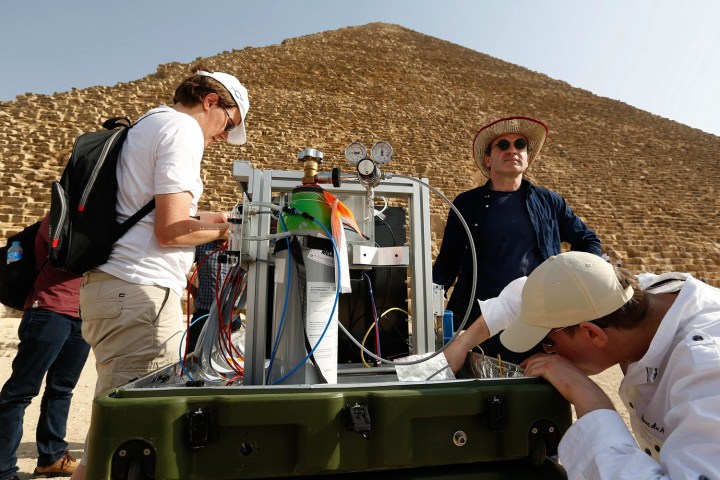
Jump forward 200 years to 2017.
“Our top priority is to conduct investigations that are as little damaging as possible.”
Researchers are still exploring the Great Pyramid of Giza, and recently uncovered a new hidden chamber in the enormous structure. But you wouldn’t know just by looking at the monument, unlike Caviglia’s handiwork. That’s because the team of international researchers, operating as part of the ScanPyramids initiative, were able to discover the 100-foot space using a non-invasive particle physics-based technique called “muon tomography,” similar to the technology that allows a doctor to X-ray your bones. To get a better a look at the space, in the future they plan to explore it using an inflatable blimp-style robot that can enter the otherwise inaccessible chamber through a tiny hole in the wall.
“Our top priority is to conduct investigations that are as little damaging as possible to heritage buildings. This is why the ScanPyramids mission started with an extensive use of non-invasive, non-damaging techniques like muography,” Dr. Jean-Baptiste Mouret, a senior researcher working on the project, previously told Digital Trends. “And this is why if, one day, a team bores a hole in a 4,000-year old monument like the Great Pyramid, the hole will have to be as small as possible. Ideally, the hole would be so small that it would be invisible.”
This is just one example of the way that modern technology is helping revolutionize the field of archaeology as we know it. Yes, technology can help lead us to a brighter future — but it turns out that it’s pretty darn good at illuminating the past as well.
“There is a long history of innovative technology in archaeology, especially in Egypt.”
“There is a long history of innovative technology in archaeology, especially in Egypt,” Mouret continued. “For instance, in the Cheops’ Pyramid, there have been investigations in the 1980s with micro-gravimetry measurements, then with ground-penetrating radars, and now with cosmic-ray muons. Several robots have also been used in the Cheops’ Pyramid to explore the ‘air-shafts.’ Beyond this pyramid, satellite imagery was key in many recent discoveries in archaeology, and the list of technologies that have been useful can go on. What may have changed the game in the recent years is the power of modern computers: We can now often analyze, combine, and visualize very complex data on a consumer laptop.”
It’s not just today’s killer laptops that are helping revolutionize modern archaeology, though. A plethora of tools once available only inside research labs are now affordable and accessible to everyone, including those interested in peering backwards as well as forwards.
For example, last year, scientists used readily available Lidar — a tool most readily associated with helping autonomous cars to sense the world around them — to create a detailed map of a long-lost city hidden beneath the jungle in Cambodia. In Europe, an E.U.-funded initiative called the ROVINA project (Robots for Exploration, Digital Preservation and Visualization of Archeological Sites) is meanwhile taking advantage of modern robotics breakthroughs to build robots especially designed to explore historical sites. Just like the Great Pyramid, technology can be used to find new ways to gather data on historical sites that would be difficult or downright dangerous for human beings to explore in person.
“Robotics technology has a lot to offer in terms of digital preservation of historical sites,” Wolfram Burgard, professor for computer science at the University of Freiburg and ROVINA principle investigator, told Digital Trends. “In particular the ability to more flexibly move the sensors to get to view-points typically not accessible by humans, and to combine multiple views into larger models might play an important role.”
Some projects have attracted big names, too. In Germany, Intel has leant support to Bauhaus University Weimar, which will use drones to help protect the region’s 15th century Halberstadt Cathedral. Specifically, the project uses Falcon 8+ drones to capture ultra-precise three-dimensional structural data, which can be used to advise on where repairs are needed.
VR and AR can transform dusty ruins into vibrant, three-dimensional worlds.
“Some of these assets were in such a delicate condition that using ladders and building scaffolding in near proximity to the structures to carry out this task may have caused more damage,” Anil Nanduri, vice president and general manager within Intel’s New Technology Group, told Digital Trends. “The Intel Falcon 8+ drone was able to do the detailed image capture and 3D modeling without the necessity for close physical contact with the assets.”
Once this data is gathered using cutting edge technology, it can be presented to audiences in fresh ways too. Virtual reality (VR) and augmented reality (AR) can transform dusty ruins into vibrant, three-dimensional worlds to give a sense of what it was like in, say, Ancient Greece at a time when it was altogether less ancient. 3D scanning and 3D printing tools can also help produce either virtual or physical reproductions of objects people would never usually have the opportunity to get up close and personal with.
“New generation of innovators are now more inspired by collective multidisciplinary adventures — [such as] space adventures — than by solitary adventurers,” Mehdi Tayoubi, president and co-founder of ScanPyramids, told Digital Trends. “Innovation even in archeology is now about breaking the silos between disciplines and countries for collective action in the respect of everyone’s contribution. ScanPyramids includes artists, engineers and scientists from Egypt, Japan, France, and Canada.” The cross-pollination between these disciplines, Tayoubi suggests, can help find new ways to approach problems.
Archaeology is by no means the only field that’s currently benefiting from the enormous advances in tech disciplines ranging from robotics and AI to 3D printing and VR. However, there’s something kind of brilliant about a subject that’s, by design, focused on the past being so proactive about looking to the future for answers.
Move over Indiana Jones; it’s all about robots here in 2017!



